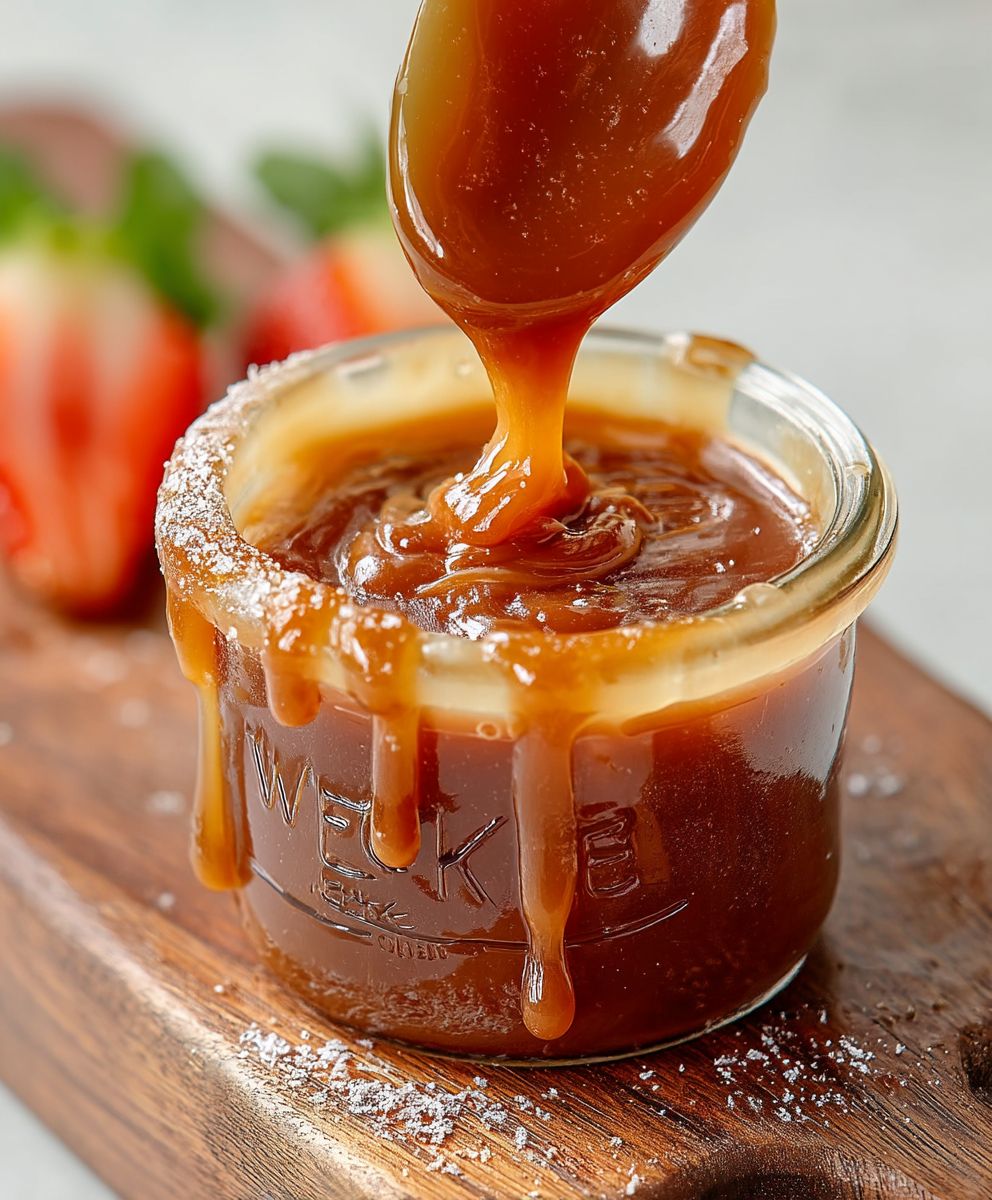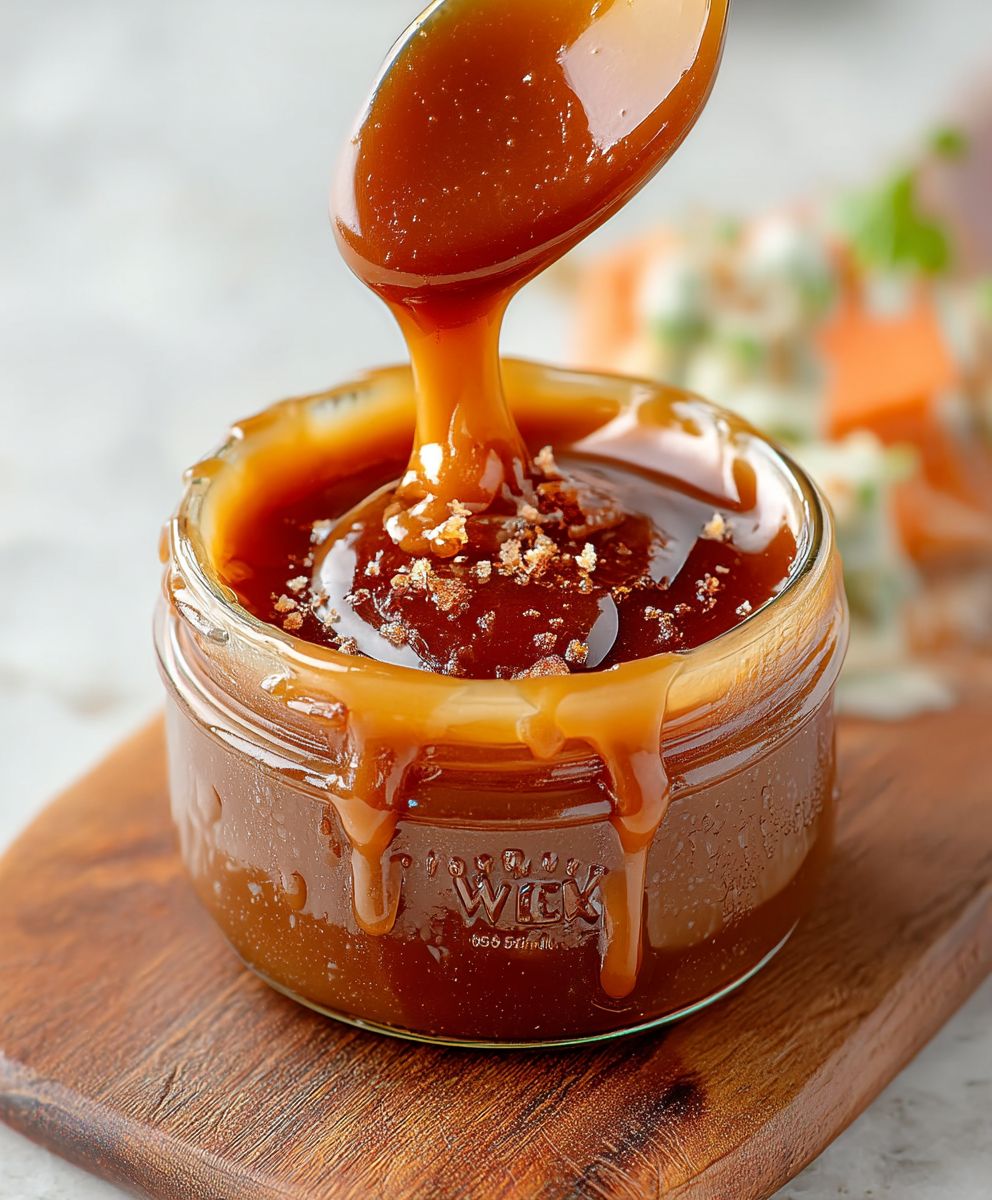Homemade Caramel Sauce: the golden elixir that elevates everything from a simple scoop of vanilla ice cream to a decadent apple pie. Have you ever tasted a dessert and thought, “This is good, but it’s missing something?” Nine times out of ten, that “something” is a generous drizzle of luscious, perfectly balanced caramel sauce.
Caramel, in its simplest form, has been around for centuries, with its origins tracing back to the Middle East. The process of caramelizing sugar was a happy accident, born from experimentation with heating and sweetening. Over time, it evolved into the rich, complex flavor we know and love today. While commercially produced caramel sauces are readily available, nothing compares to the depth and satisfaction of crafting your own homemade caramel sauce from scratch.
What is it about caramel that captivates our taste buds? It’s the perfect marriage of sweet and slightly bitter, a symphony of flavors that dance on your tongue. The smooth, velvety texture is incredibly satisfying, and the aroma alone is enough to make your mouth water. Plus, making it at home allows you to control the ingredients and customize the flavor to your liking. Whether you prefer a classic, buttery caramel or one infused with sea salt or vanilla bean, the possibilities are endless. Get ready to embark on a culinary adventure and discover the joy of creating your own liquid gold!
Ingredients:
- 1 cup (200g) granulated sugar
- 1/4 cup (60ml) water
- 1/2 cup (120ml) heavy cream, warmed
- 4 tablespoons (57g) unsalted butter, cut into 4 pieces
- 1/2 teaspoon sea salt (or to taste)
Preparing the Caramel:
- Combine Sugar and Water: In a medium-sized, heavy-bottomed saucepan, combine the granulated sugar and water. Use a saucepan that is light in color so you can easily monitor the color of the caramel as it cooks. This is crucial for preventing burning.
- Cook Over Medium Heat: Place the saucepan over medium heat. At first, the sugar will dissolve into the water. You might see some sugar crystals clinging to the sides of the pan. Don’t worry about these just yet.
- Resist Stirring (Initially): This is important! Do NOT stir the mixture at this stage. Stirring can cause the sugar to crystallize and ruin your caramel. Let the mixture come to a boil undisturbed.
- Wash Down the Sides (If Needed): If you see sugar crystals forming on the sides of the pan, use a wet pastry brush to gently wash them down. Dip the brush in water and carefully brush the crystals back into the simmering sugar mixture. This helps prevent crystallization.
- Monitor the Color: As the sugar mixture boils, it will start to change color. It will go from clear to a light golden color, then to a deeper amber. This is where you need to pay close attention. The color is your guide to the doneness of the caramel.
- Swirl the Pan (If Needed): If the caramel is browning unevenly, you can gently swirl the pan to distribute the heat. Avoid stirring with a utensil, as this can still promote crystallization.
- Cook to Amber Color: Continue cooking until the caramel reaches a deep amber color. This usually takes about 8-10 minutes, but it can vary depending on your stove and saucepan. Be patient and watch it carefully. You want a rich amber color, but you don’t want it to burn. Burnt caramel will taste bitter.
- Remove from Heat: Once the caramel reaches the desired amber color, immediately remove the saucepan from the heat. This is crucial to prevent it from burning.
Adding the Cream and Butter:
- Carefully Add the Warm Cream: This is a critical step, so be prepared! Pour the warm heavy cream into the caramel. The mixture will bubble vigorously and steam will be released. Be very careful to avoid burns. The caramel will seize up and harden when the cold cream is added. Don’t panic, this is normal.
- Whisk Vigorously: Immediately whisk the cream into the caramel. The mixture will be lumpy at first, but keep whisking. The heat from the caramel will eventually melt the hardened sugar and the mixture will become smooth.
- Add the Butter: Add the butter pieces to the caramel mixture.
- Whisk Until Smooth: Continue whisking until the butter is completely melted and incorporated into the caramel. The mixture should be smooth and glossy.
- Add the Salt: Stir in the sea salt. Start with 1/2 teaspoon and then taste the caramel. Add more salt if desired, to your preference. The salt balances the sweetness and enhances the flavor of the caramel.
Finishing and Storing:
- Cool Slightly: Let the caramel sauce cool slightly in the saucepan for a few minutes. This will allow it to thicken slightly.
- Transfer to a Jar: Pour the caramel sauce into a clean glass jar or heat-safe container. Be careful, as the caramel will still be hot.
- Cool Completely: Let the caramel sauce cool completely to room temperature. As it cools, it will thicken further.
- Store Properly: Once cooled, seal the jar tightly and store the caramel sauce in the refrigerator for up to 2 weeks.
- Reheat Before Serving: Before serving, you may need to reheat the caramel sauce slightly, as it will thicken considerably in the refrigerator. You can reheat it in the microwave in 15-second intervals, stirring in between, or you can gently warm it in a saucepan over low heat.
Tips for Perfect Caramel Sauce:
- Use a Heavy-Bottomed Saucepan: A heavy-bottomed saucepan will distribute heat more evenly and prevent the caramel from burning.
- Warm the Cream: Warming the cream before adding it to the caramel helps prevent the caramel from seizing up and becoming lumpy.
- Don’t Overcook the Caramel: Overcooked caramel will taste bitter. Watch the color carefully and remove the saucepan from the heat as soon as the caramel reaches a deep amber color.
- Be Careful When Adding the Cream: Adding the cream to the hot caramel can cause it to bubble vigorously and release steam. Be very careful to avoid burns.
- Adjust the Salt to Your Taste: The amount of salt you add to the caramel is a matter of personal preference. Start with 1/2 teaspoon and then add more if desired.
- Clean Up Quickly: Cleaning up after making caramel can be tricky, as the hardened sugar can be difficult to remove. Soak the saucepan in hot water for a few hours to dissolve the sugar.
- Troubleshooting Crystallization: If your sugar crystallizes during the cooking process, don’t despair! Add a tablespoon or two of lemon juice or corn syrup to the mixture. These ingredients can help prevent further crystallization and may even dissolve existing crystals. However, it’s best to avoid stirring in the first place to minimize the risk.
- Preventing Splattering: When adding the warm cream, the mixture will splatter. Using a splatter screen can help contain the mess and prevent burns. Alternatively, pour the cream in a slow, steady stream while whisking constantly.
- Flavor Variations: Once you’ve mastered the basic caramel sauce, you can experiment with different flavor variations. Try adding a splash of vanilla extract, a pinch of cinnamon, or a tablespoon of bourbon to the finished sauce.
- Using a Candy Thermometer: While not strictly necessary, a candy thermometer can provide more precise control over the caramel-making process. Aim for a temperature of around 340°F (170°C) for a deep amber caramel.
- High Altitude Adjustments: If you live at a high altitude, you may need to adjust the cooking time slightly. Water boils at a lower temperature at higher altitudes, so the caramel may take longer to reach the desired color.
Serving Suggestions:
- Drizzle over ice cream
- Use as a dip for apples or pretzels
- Pour over cakes or brownies
- Stir into coffee or hot chocolate
- Use as a filling for tarts or pies
Why This Recipe Works:
This recipe is designed to be foolproof by emphasizing the importance of using a heavy-bottomed saucepan for even heat distribution, which prevents scorching. The instruction to warm the cream before adding it to the caramel is crucial because it minimizes the temperature shock that can cause the caramel to seize up and become lumpy. The detailed instructions on monitoring the color of the caramel are vital, as the color is the best indicator of doneness and prevents overcooking, which leads to a bitter taste. The inclusion of troubleshooting tips, such as how to handle crystallization, ensures that even beginners can successfully make caramel sauce. Finally, the recipe encourages experimentation with flavor variations, allowing users to customize the sauce to their preferences. The emphasis on careful whisking and the gradual addition of ingredients ensures a smooth and consistent texture.

Conclusion:
And there you have it! This homemade caramel sauce recipe is truly a game-changer. Forget the store-bought stuff once you taste the rich, buttery, and deeply satisfying flavor of this homemade version, you’ll never go back. It’s incredibly easy to make, requiring just a few simple ingredients and a little bit of patience. The result is a decadent sauce that elevates everything it touches.
Why is this a must-try? Because it’s more than just a sauce; it’s an experience. It’s the warm, comforting aroma filling your kitchen as it simmers. It’s the satisfying swirl of golden brown as the sugar transforms. And most importantly, it’s the pure, unadulterated joy of that first taste. It’s a simple pleasure that makes any dessert (or even your morning coffee!) feel incredibly special.
But the fun doesn’t stop there! This homemade caramel sauce is incredibly versatile. Looking for serving suggestions? Drizzle it generously over vanilla ice cream for a classic treat. Use it as a dip for crisp apple slices for a delightful autumn snack. Swirl it into your favorite brownie batter for an extra layer of indulgence. Or, for a truly decadent experience, use it as a filling for homemade chocolates. The possibilities are endless!
And if you’re feeling adventurous, why not try some variations? For a salted caramel sauce, simply add a pinch of sea salt at the end. For a deeper, more complex flavor, try using brown sugar instead of granulated sugar. You could even infuse the sauce with spices like cinnamon or cardamom for a warm, festive twist. A splash of bourbon or rum at the end adds a sophisticated touch for adult desserts. Experiment and find your perfect caramel creation!
I truly believe that everyone should have a go-to caramel sauce recipe, and this is mine. It’s reliable, delicious, and always a crowd-pleaser. It’s the perfect way to add a touch of sweetness and sophistication to any occasion.
So, what are you waiting for? Gather your ingredients, put on some music, and get ready to create some caramel magic. I promise you won’t regret it.
And most importantly, I want to hear about your experience! Did you try the recipe? What variations did you make? What did you serve it with? Share your photos and stories in the comments below. I can’t wait to see what you create! Let me know if you have any questions or need any help along the way. Happy caramel-making! I’m confident you’ll find this homemade caramel sauce to be a delightful addition to your culinary repertoire. Enjoy!
Homemade Caramel Sauce: Easy Recipe & Tips for Perfect Results
Rich, decadent homemade caramel sauce for drizzling, dipping, or desserts.
Ingredients
- 1 cup (200g) granulated sugar
- 1/4 cup (60ml) water
- 1/2 cup (120ml) heavy cream, warmed
- 4 tablespoons (57g) unsalted butter, cut into 4 pieces
- 1/2 teaspoon sea salt (or to taste)
Instructions
- Combine the granulated sugar and water in a medium-sized, heavy-bottomed saucepan. Use a light-colored saucepan to easily monitor the caramel’s color.
- Place the saucepan over medium heat. The sugar will dissolve.
- Do NOT stir the mixture. Let it come to a boil undisturbed.
- If sugar crystals form on the sides of the pan, use a wet pastry brush to gently wash them down.
- Monitor the color as the mixture boils. It will go from clear to light golden, then to a deeper amber.
- If the caramel is browning unevenly, gently swirl the pan to distribute the heat.
- Cook until the caramel reaches a deep amber color (about 8-10 minutes). Watch carefully to avoid burning.
- Immediately remove the saucepan from the heat.
- Carefully pour the warm heavy cream into the caramel. The mixture will bubble vigorously and steam will be released. Be very careful to avoid burns.
- Immediately whisk the cream into the caramel. The mixture will be lumpy at first, but keep whisking until smooth.
- Add the butter pieces to the caramel mixture.
- Whisk until the butter is completely melted and incorporated. The mixture should be smooth and glossy.
- Stir in the sea salt. Start with 1/2 teaspoon and add more to taste.
- Let the caramel sauce cool slightly in the saucepan for a few minutes.
- Pour the caramel sauce into a clean glass jar or heat-safe container.
- Let the caramel sauce cool completely to room temperature.
- Seal the jar tightly and store the caramel sauce in the refrigerator for up to 2 weeks.
- Reheat before serving in the microwave in 15-second intervals, stirring in between, or gently warm in a saucepan over low heat.
Notes
- Use a heavy-bottomed saucepan for even heat distribution.
- Warming the cream prevents the caramel from seizing up.
- Don’t overcook the caramel, or it will taste bitter.
- Be careful when adding the cream, as it will bubble vigorously.
- Adjust the salt to your taste.
- If sugar crystallizes, add a tablespoon or two of lemon juice or corn syrup.
- Experiment with flavor variations like vanilla extract, cinnamon, or bourbon.
- A candy thermometer can be used; aim for 340°F (170°C).
- High altitude may require adjusting the cooking time.

